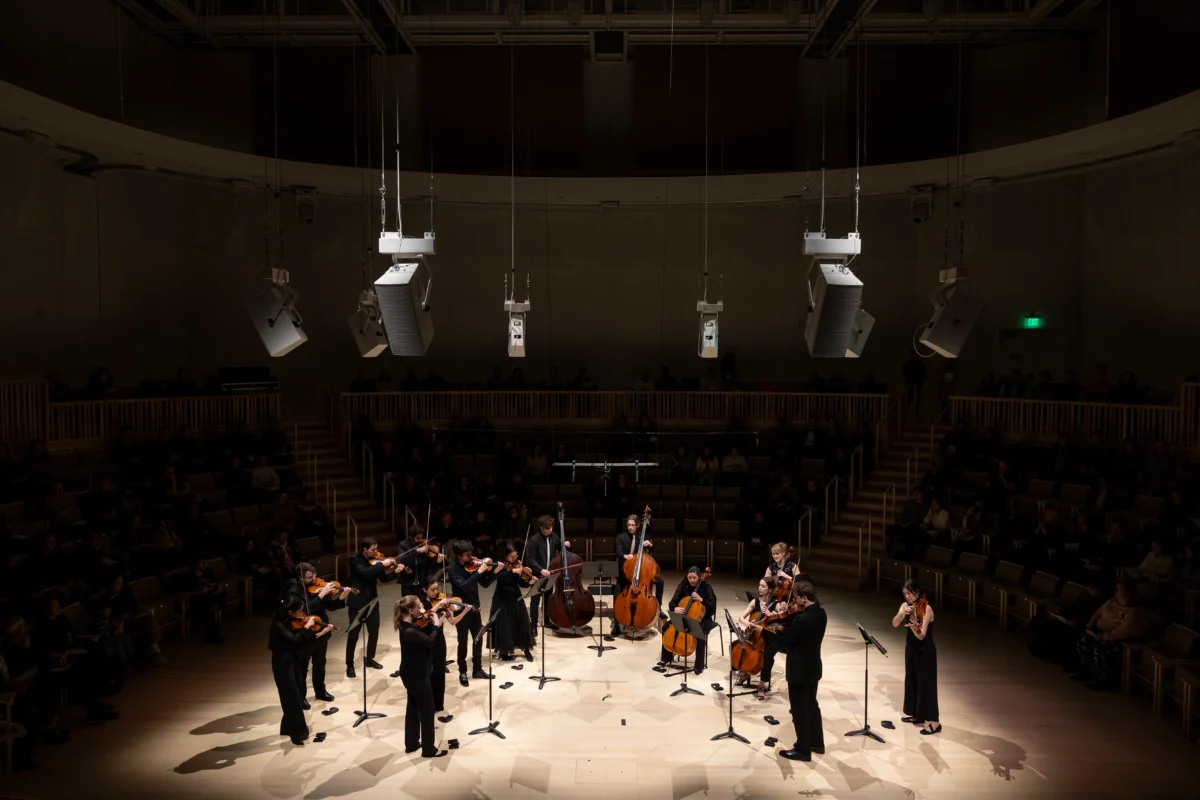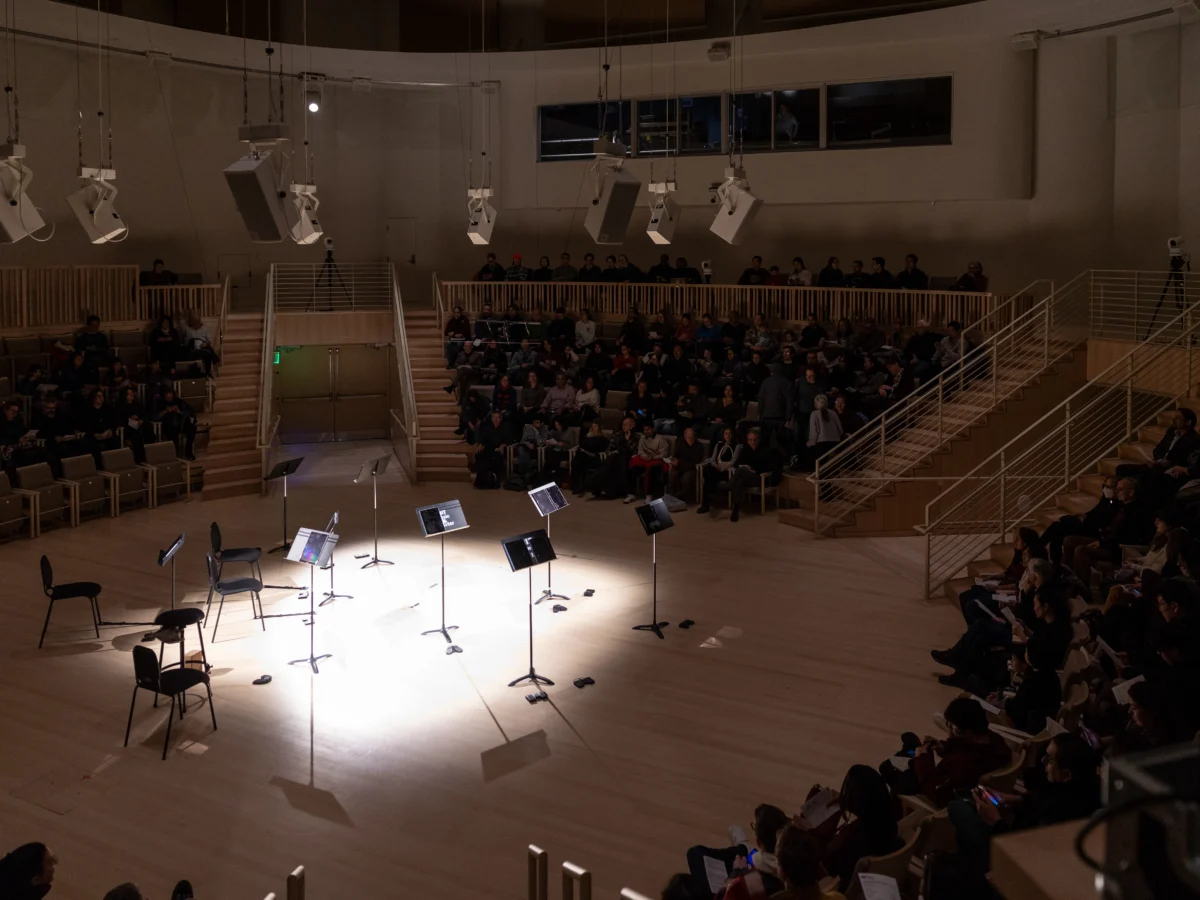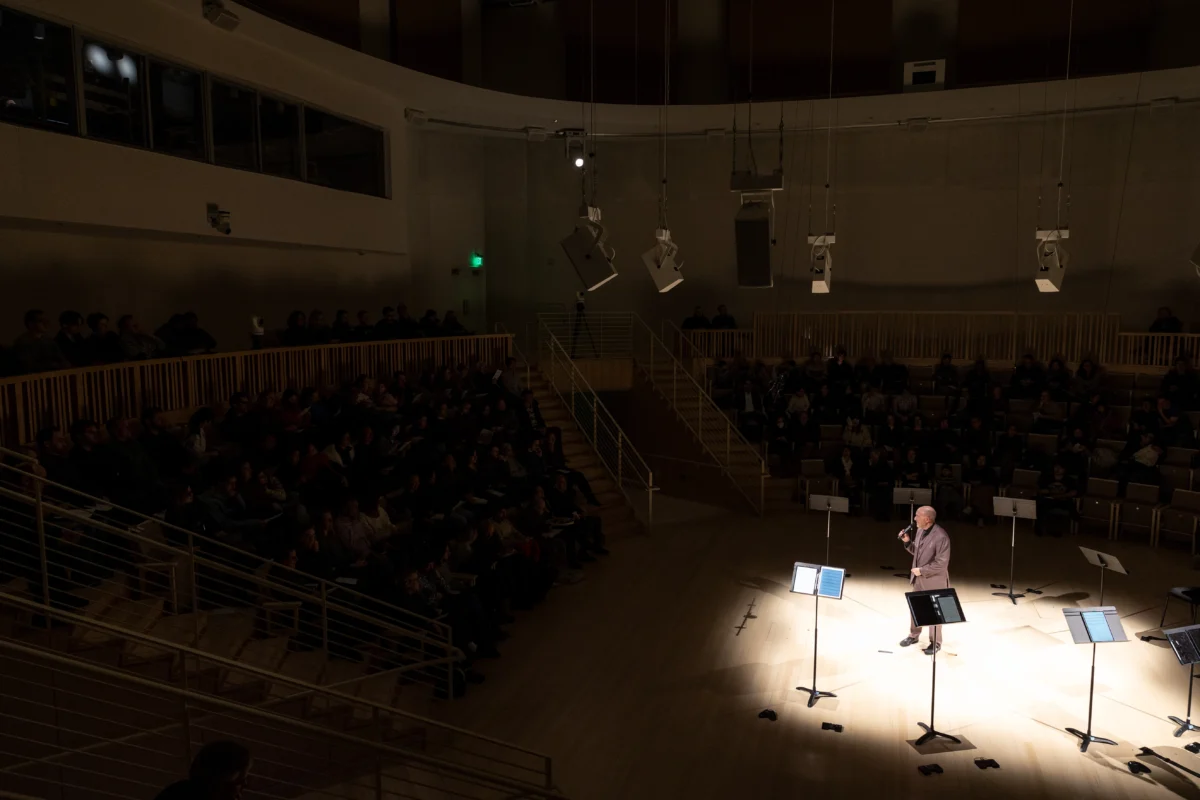Kinetic Ensemble, a 16-piece string orchestra that came to Boston for a weeklong residency at MIT, may play without a conductor. But that hardly means the ensemble lacks direction. Or a signature sound. “Our audiences tell us there is a different kind of energy at our concerts,” says Natalie Lin Douglas, associate professor in Music & Theater Arts (MTA) at MIT, who founded the Houston-based artist-led and curated ensemble. “It takes a certain type of musician to want to work this way, to make decisions collaboratively, to put in the extra time. But we feel the result is well worth it.”
Starting on February 17 Kinetic Ensemble’s MIT residency included two masterclasses for MIT students, sectionals with the MIT Symphony Orchestra, an open rehearsal demonstration. The residency culminated on February 22 with a concert in Thomas Tull Concert Hall in the newly opened Edward and Joyce Linde Music Building. The concert, which is part of Artfinity—an Institute-sponsored campus-wide festival celebrating creativity and community at MIT—was inspired by the themes of human invention, cultural heritage, and the natural world. (To watch a livestream of the performance, please click here.) It featured world premiere pieces composed by MIT faculty Miguel Zenón and Evan Ziporyn, American composer Viet Cuong’s “Next Week’s Trees,” and the Boston premiere of “The Wilderness Anthology,” a piece for string orchestra and recorded soundscapes written by guest composer Patrick Harlin. Harlin participated in “From Antarctica to the Amazon,” a public talk about music, sustainability, and exploration with Professor of Environmental Studies and Chemistry Susan Solomon on February 21.
“It is a genuine thrill to work with Kinetic Ensemble,” says Harlin, whose “Wilderness Ensemble” appears on Kinetic Ensemble’s debut album “Kinetic” (2023) . Originally composed in 2016, and expanded in 2022, the piece weaves sounds Harlin recorded in remote endangered areas together with live music played by musicians on stage. “Because they play without a conductor, they need to communicate in a different way. There’s so much more intensity in the music and audiences respond to it. They are also amazing string players, which is a luxury for any composer. You can write anything and know they will play it well.”
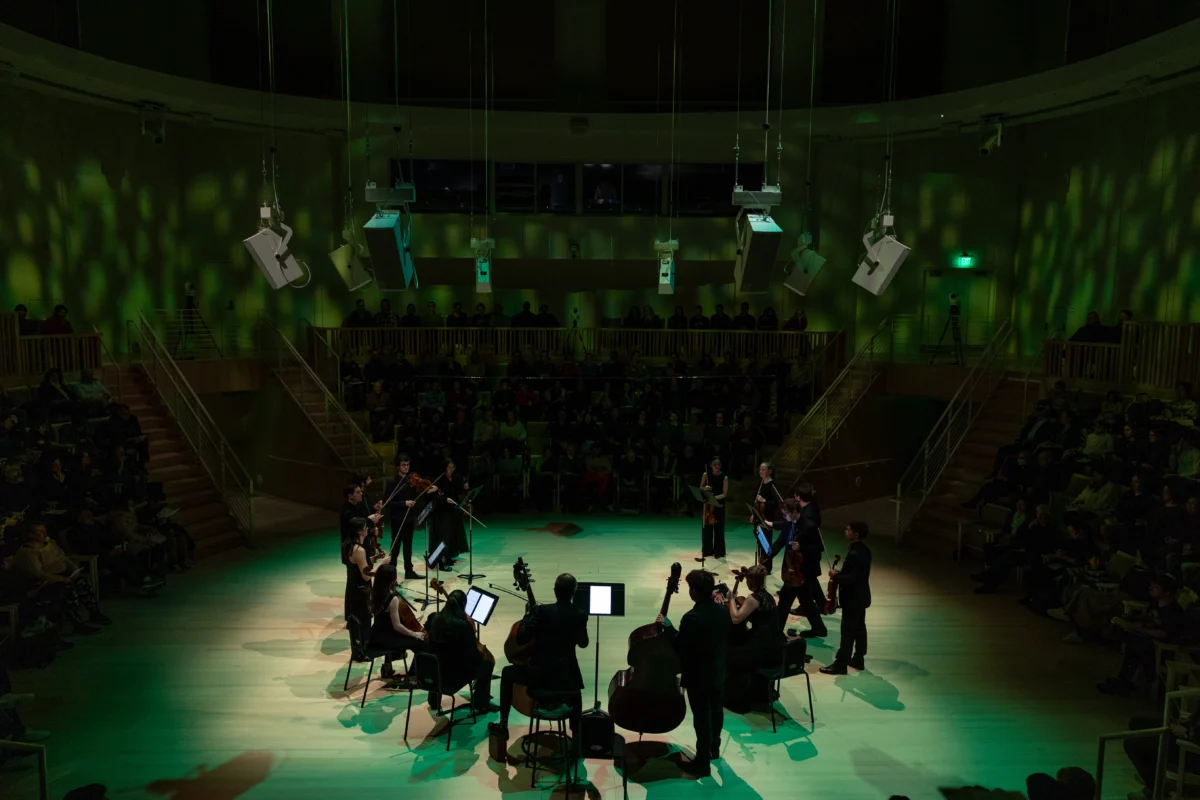
The Birth of Kinetic
Lin Douglas created Kinetic Ensemble in 2015 as a PhD music student at Rice University in Houston. “It began as a student project,” recalls Lin Douglas, who joined the MIT Music & Theater Arts faculty in 2020. “At first, it was a way for like-minded musicians to meet, and also to play in a collaborative setting without a conductor, where musicians make decisions together in a more democratic way.”
Critics laud Kinetic Ensemble for its virtuosity, vibrant sound, and its singular repertoire. Larger than a string quartet, but smaller and more flexible than a full contemporary orchestra, Lin Douglas and her colleagues are committed to performing under-represented works from the classical canon as well as newly composed classical pieces. “Kinetic Ensemble occupies an interesting middle ground” says Austin Lewellen, a double bassist and Rice alumnus who joined Kinetic during the pandemic. “We are larger than most unconducted groups and can access the sound and colors of a larger orchestra. This opens up a broader repertoire than most chamber groups can play.”
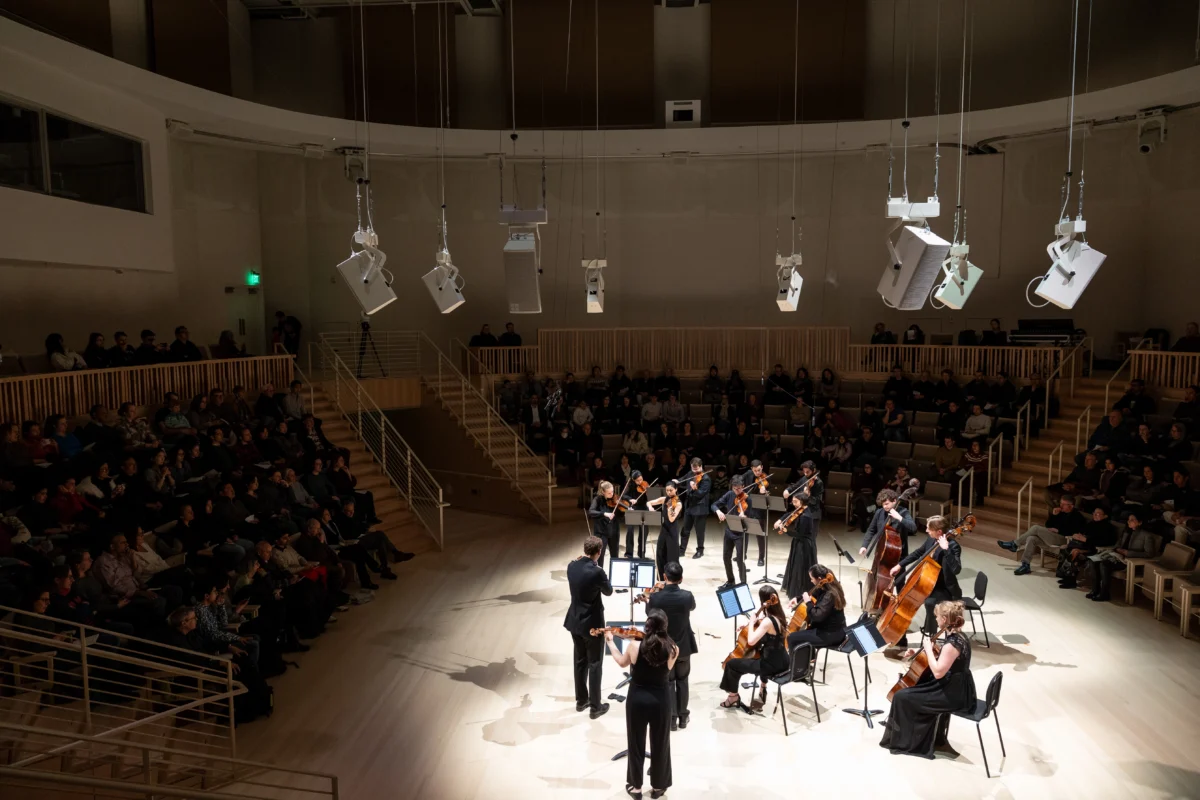
Not Without Precedent
The idea of a conductorless orchestra isn’t entirely new. Until the early 19th century, before concert orchestras swelled in size, musicians either played without a conductor or followed the lead of the first violinist or concertmaster. “What’s new about Kinetic Ensemble is their brand of leadership,” observes composer Evan Ziporyn, the Kenan Sahin Professor of Music at MIT, who led the faculty search committee that hired Lin Douglas. Ziporyn’s piece “In Light of Sound” had its world premiere at the February 22 Kinetic Ensemble concert. “It’s not a top-down organization. They make decisions collectively. It makes players not only need but want to be on their game. You can’t phone it in. What’s most striking about groups like Kinetic Ensemble is that they don’t sound directionless. They have a collective sound and identity. However they are making it work, it works very well.”
Miguel Zenón, Professor of Music, GRAMMY® Award winner and Guggenheim and MacArthur Fellow agrees. “In today’s age it seems to be extremely difficult for any ensemble to make a lasting impression in the Chamber Music world,” says the jazz saxophonist and composer. Zenón rewrote and reorchestrated “Promesa” and “Yumac”—two pieces originally composed for string quartet and alto saxophone—specifically for the February 22 Kinetic Ensemble concert. “The fact that Kinetic has achieved that is admirable on its own. On top of that they’ve done an amazing job of crafting their own sound and identity. Plus their repertoire is as adventurous as it is interesting. Natalie and I are already discussing another collaboration and performance in the very near future.”
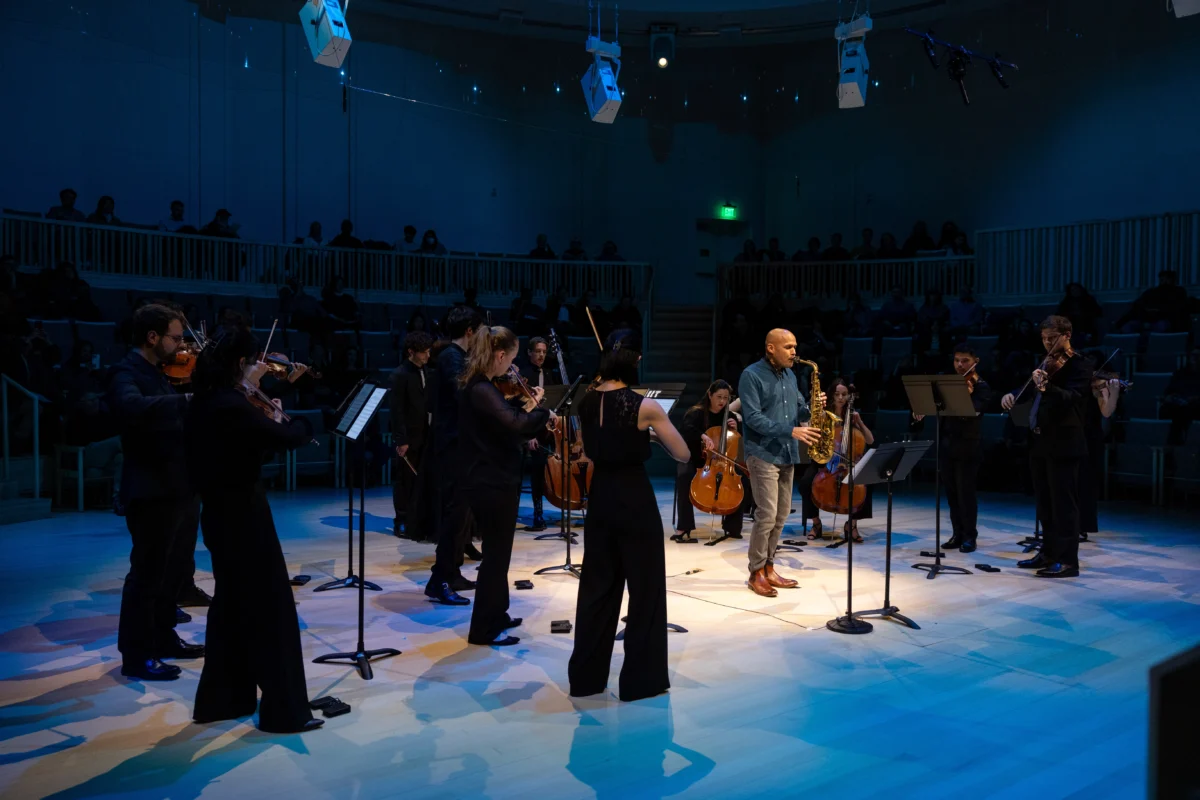
Risk and Reward
The weeklong residency held special meaning for Lin Douglas, who was gratified to bring her Kinetic Ensemble colleagues to meet with students at MIT. She was also pleased to perform the worlds of her MIT faculty colleagues at the Thomas Tull Concert Hall. “Evan Ziporyn’s piece is conceived with this concert hall in mind, with the ensemble split and placed symmetrically, in halves to take advantage of the in-the-round setting” she says. “Patrick Harlin’s piece blends sounds of nature with musical sounds that resonated in the hall. And Miguel Zenón specifically rearranged two pieces for our ensemble, to play at this concert. It was a rare privilege to have those three composers present. We are very lucky.”
While Kinetic Ensemble’s sound and story are interesting on their own, Lin Douglas believes the ensemble’s method holds lessons that go beyond music. “There is an inherent risk in any leaderless or collaborative approach,” she says. “It won’t work unless everyone involved is fully invested. And you need to make a lot of decisions that traditional ensembles with a conductor don’t need to consider: who will cue this part of the piece; who will set the tempo here. But learning to work these things out together, over time, learning to make decisions as a group has applications in all kinds of settings, not just in music or art but in every field where people work in groups. And apart from that, and maybe most importantly, it’s a lot of fun.”
Kinetic Ensemble’s visiting artist residency was organized through the MIT Center for Art, Science & Technology (CAST). Their concert was part of Artfinity, the Institute-sponsored event celebrating creativity and community at MIT. Artfinity is organized by the Office of the Arts.
You can watch a livestream of the performance at this link.
Written by Ken Shulman
Editorial direction by Leah Talatinian
Kinetic Ensemble
Natalie Lin Douglas, founder & artistic director
Violin
Cindy Sohyun Ahn (Houston)
Kami Ghavi-Helm (Houston)
Mary Grace Johnson (on faculty at West Virginia University)
Giancarlo Latta (NYC)
Natalie Lin Douglas (associate professor at MIT)
Emily Richardson (Houston)
Christiano Rodrigues (on faculty at Washington State University)
Jacob Schafer (Houston)
Viola
Tonya Burton (on faculty at Sam Houston State University)
Sebastian Stefanovic (member of Florida Orchestra)
Sergein Yap (Houston)
Cello
Bree Ahern (Fort Worth)
Jamie Clark (on faculty at University of Idaho)
Patricia Ryan (Minnesota)
Bass
Austin Lewellen (Houston/NYC)
Charles Paul (member of Cleveland Orchestra)

